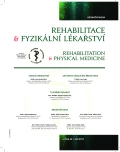The Inpatient Rehabilitation after Lower Limb Amputation, Evaluation by Functional Walk Tests
Authors:
A. Čurdová 1; E. Vaňásková 1,2
Authors‘ workplace:
Rehabilitační klinika FN Hradec Králové
1; Lékařská fakulta UK v Hradci Králové
2
Published in:
Rehabil. fyz. Lék., 24, 2017, No. 3, pp. 160-165.
Category:
Original Papers
Overview
Aim:
The aim of the thesis was to evaluate the ability of walking with prosthesis in lower limb amputees. We evaluated the effect of amputation level on functional walk tests results in different groups of amputees during their first and second hospital stay.
Methods:
A retrospective analysis was conducted with data collected from August 2014 to December 2015 in Department of Rehabilitation University Hospital Hradec Kralove. Functional tests were measured in 37 transfemoral and transtibial amputees at the beginning and at the end of their first hospital stay. Other group concluded of 17 transfemoral and transtibial amputees of their second hospital stay. The evaluation was carried out on the basis of the following functional tests: Parallel bars test, the Timed Up and Go Test, 10 Meter Walk Test. The average length of hospital stay was 19.5 days.
Results:
68 % of transtibial amputees were able to undergo all of the tests during their first hospital stay. The majority of transtibial amputees (90 %) were able to undergo most difficult tests during their second hospital stay. 50 % of transfemoral amputees were able to undergo all of the tests during their first hospital stay with comparison with 42,9 % transfemoral amputees during their second hospital stay.
Conclusions:
The results suggest that patients with unilateral transtibial amputation got better results in functional walk tests than patients with transfemoral amputation. The level of leg amputation had influence on walking with prosthesis.
KEYWORDS:
amputation, Functional Walk Tests, Timed Up and Go Test, 10 Meter Walk Test, rehabilitation
Sources
1. BROOKS, D., PARSONS, J., HUNTER, J. P., DEVLIN, M., WALKER, J.: The 2 minute test as a measure od functional improvement in persons with lower limb amputation. Arch. Phys. Med. Rehabil., roč. 82, 2001, č. 10, s. 1562-1565.
2. BŘEZINOVÁ, M.: Hodnotenie funkčného potenciálu u pacientov po amputácii dolných končatín. Rehabilitácia, roč. 52, 2015, č. 4, s. 218-226
3. DUNGL, P. et al.: Ortopedie. Praha, Grada Publishing, a.s, 2005, s. 1273.
4. EPRAIM, P. L, WEGENER, S. T, MacKENZIE, E. J. et al.: Phantom pain, residual limb pain, and back pain in amputees: results of a national survey. Arch. Phys. Med. Rehabil, roč. 86, 2005, s. 1910-1919.
5. ESQUENAZI, A., MEIER, R. H.: Rehabilitation in limb deficiency. 4. Limb amputation. Arch. Phys. Med. Rehabil., roč. 77, 1996, č. 3, s. 18-28.
6. FLETCHER, D. D, ANDREWS, K. L, HALLETT, J. W Jr., BUTTERS, M. A., ROWLAND, C. M., JACOBSEN, S. J.: Trends in rehabilitation after amputation for geriatric patients with vascular disease: implications for future health resource allocation. Arch. Phys. Med. Rehabil., roč. 83, 2002, č. 10, s. 1389-1393.
7. GAUTHIER-FIAGNON, C. H., GRISE, M. C., POTVIN, D.: Predisposing factors related to prosthetic use by people with a transtibial and transfemoral amputation. JPO Journal of Prosthetics & Orthotics, roč. 10, 1998, č. 4, s. 99-109.
8. JANURA, M., KUBEŠOVÁ, G., SVOBODA, Z., VAŘEKA, I., JANUROVÁ, E., ELFMARK, M.: Problematika otevřených a uzavřených kinematických řetězců dolních končetin při chůzi. Rehabilitácia, roč. 50, 2013, č.3, s. 131-140.
9. JONES, L., HALL, M., SCULD, W.: Ability or disability? A study of an functional outcome of 65 consequtive lower- limb amputees treated in the Royal South Sydney Hospital in 1988-1989. Disabil. Rehabil., roč. 5, 1993, s. 184-188.
10. KÁLAL, J.: K současným problémům lokomoce amputovaných na dolní končetině. Rehabilitácia, roč. 42, 2005, č. 1, s. 20-29.
11. KALAPATAPU, V.: Lower extremity amputation. UpToDate [online]. unknown: unknown, 2016 [cit. 2016-02-09]. Dostupné z https://www.uptodate.com/contents/lower-extremity-amputation.
12. KARANIKOLAS, M., ARETHA, D., TSOLAKIS, I. et al.: Optimized perioperative analgesia reduces chronic phantom limb pain intensity, prevalence, and frequency: a prospective, randomized, clinical trial. Anesthesiology, roč. 114, 2011, č. 5, s. 1144-1154.
13. LUSARDI, M. M., NIELSEN, C. C.: Orthotics and prosthetics in rehabilitation. 2nd ed. 2007 Elsevier Inc., s. 904.
14. NAGANO, K., HORI, H., MURAMATSU, K.: A comparison of at-home walking and 10-meter walking test parameters of individuals with post-stroke hemiparesis. Journal of Physical Therapy Science, roč. 27, 2015, č. 2, s. 357-359.
15. NEHLER, M. R., COLL, J. R., HIATT, W. R., et al.: Functional outcome in a contemporaray series of major lower extremity amputations. Journal of Vascular Surgery, roč. 38, 2003, s. 7-14.
16. NOWYGROD, R., EGOROVA, N., GRECO, G. et al.: Trends, complications, and mortality in peripheral vascular surgery. Journal of Vascular Surgery, roč. 43, 2006, s. 205-216.
17. PODSIADLO, D., RICHARDSON, S.: The timed „Up and Go“:a test of basic functional mobility for frail elderely persons. Journal of American Geriatric Society, roč. 39, 1991, s. 142-148.
18. RYBKA, J.: Diabetes mellitus - komplikace a přidružená onemocnění: diagnostické a léčebné postupy. 1. vyd., Praha, Grada, 2007, s. 311.
19. SOSNA, A.: Základy ortopedie. Praha, TRITON, 2001, s. 157.
20. VAŘEKA, I., BEDNÁŘ, M., VAŘEKOVÁ, R.: Kvalitativní hodnocení a testování u pacientů po amputaci dolní končetiny. Rehabil. a fyz. Lék., roč. 21, 2014, č. 1, s. 3-10.
Labels
Physiotherapist, university degree Rehabilitation Sports medicineArticle was published in
Rehabilitation & Physical Medicine

2017 Issue 3
- Hope Awakens with Early Diagnosis of Parkinson's Disease Based on Skin Odor
- Deep stimulation of the globus pallidus improved clinical symptoms in a patient with refractory parkinsonism and genetic mutation
Most read in this issue
- Examination of the Patellofemoral Joint with Magnetic Resonance and Targeted Physiotherapy Procedures in Treatments of Retropatellar Pain
- Constraint Induced Movement Therapy Patients after Stroke
- The Inpatient Rehabilitation after Lower Limb Amputation, Evaluation by Functional Walk Tests
- Influence of Coactivation Therapy on Stability of Children with Cerebral Palsy
